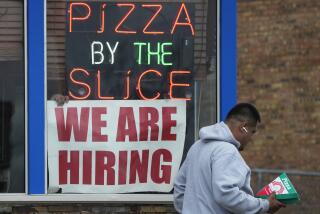Housing Starts Fall 10.1% in April
- Share via
WASHINGTON — Construction of new homes and apartments fell for the third consecutive month in April, the government reported Tuesday, a sign that last year’s record pace of home sales isn’t likely to be matched.
Starts fell 10.1% last month to a seasonally adjusted annual rate of 1.574 million, the biggest monthly decline in five years, Commerce Department figures showed. The decline followed drops of 0.1% in March and 3.7% in February.
Even so, builders say 1999 will still be one of their best ever.
Though housing starts declined in most of the country, they rose 2% in the West to 406,000 units. “It’s probably not going to be as strong as last year but probably the top three or four years in history,” said Daryl Jesperson, president of Re/Max International Inc., a global real estate franchiser based in Greenwood Village, Colo., that registered more than 1 million real estate transactions last year.
In the first four months of the year, builders started work on 515,000 homes, on an unadjusted basis, which is 9.6% more houses than the same period last year--evidence that “demand for housing is still strong,” said Tim McGee, chief economist at Tokai Bank Ltd. in New York.
Warm weather in January pushed starts that month to a 12-year high and “there was no way that the pace could be maintained,” said Joel Naroff, chief economist of Naroff Economic Advisors in Holland, Pa.
Meanwhile, another report released Tuesday showed that U.S. apartment rents rose 5% in the first quarter, the biggest annualized gain this decade, as demand spurred by a strong economy outpaced new construction.
“Renters who moved or renewed apartment leases in the last few months likely experienced some sticker shock,” said Ron Witten, president of apartment research firm M/PF Research Inc. of Dallas, the report’s author.
The report comes just days after government figures showed that the prices U.S. consumers pay for goods and services rose in April at the fastest pace in nine years.
While rents rose, the average occupancy rate was essentially flat at 94.9%, compared with 95% a year earlier. M/PF’s study covers 3,300 apartment complexes across the country, excluding New York.
The West led the rent gains, especially California, where the average rent rose 6.7%. California’s apartment market is benefiting from job growth generated by start-up Internet companies and other high-tech industries.
“Many Western markets, particularly those in California, are experiencing rapid employment growth that is fueling demand for apartments, but not many new units are coming onstream,” Witten said.
More to Read
Inside the business of entertainment
The Wide Shot brings you news, analysis and insights on everything from streaming wars to production — and what it all means for the future.
You may occasionally receive promotional content from the Los Angeles Times.










